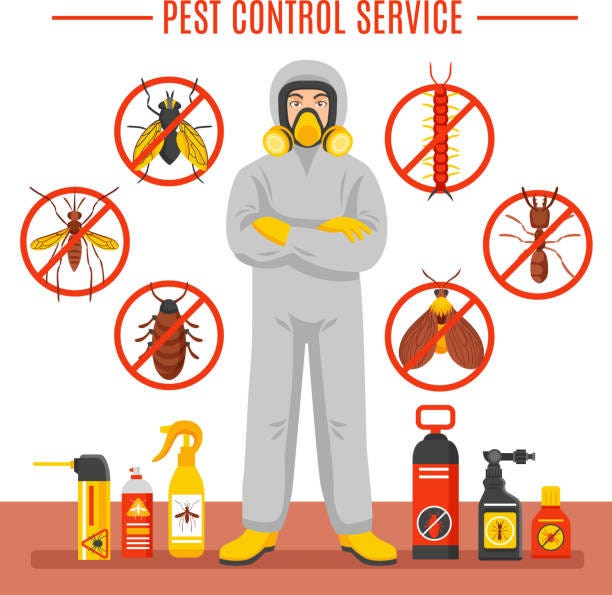Experienced A1 Exterminators Charlotte NC - Fast and Reliable Solutions
Wiki Article
Bed Pest Therapy Break Down: Comparing Chemical Vs. Non-Chemical Solutions
In the realm of parasite control, particularly when taking care of the consistent issue of bed insects, the selection between chemical and non-chemical treatment solutions can be a pivotal one. Both approaches use distinctive advantages and downsides, influencing elements such as performance, security factors to consider, and total cost. By taking a look at the nuanced information of each method, a clearer understanding of which path to go after in attending to a bed bug infestation can be obtained.Performance of Chemical Therapies
Chemical treatments for bed bug infestations have actually been extensively acknowledged for their powerful and fast efficiency in getting rid of these bugs. When thinking about the performance of chemical therapies, it is crucial to recognize that they can supply a complete and quick solution to a bed pest issue.Additionally, chemical treatments have the benefit of offering recurring effects, meaning that they can proceed to eliminate bed pests even after the first application. This residual activity is specifically advantageous in combating any possible re-infestations. Additionally, the quick activity of chemical treatments can bring alleviation to individuals encountering severe bed pest problems, enabling them to regain control of their living areas quickly.
Security Worry About Chemical Solutions
One essential aspect that needs cautious consideration when making use of chemical options for bed insect treatment is making sure the security of occupants and the setting. Exposure to certain chemicals made use of in bed insect treatments can lead to respiratory system issues, skin irritation, or various other adverse responses, particularly in individuals with pre-existing conditions or level of sensitivities.Furthermore, the ecological effect of chemical options is one more substantial consideration. Some chemicals utilized in bed bug therapies may be unsafe to useful pests, wildlife, and ecosystems if they seep into the soil or water supply. It is vital to use chemical therapies judiciously, following safety guidelines, and taking into consideration less harmful choices to mitigate these threats and guarantee the secure and effective monitoring of bed bug infestations.
Advantages of Non-Chemical Methods
Considering the potential safety and security problems and ecological influence connected with chemical remedies for bed bug treatment, discovering non-chemical strategies provides a promising alternative with several distinctive advantages. Non-chemical treatments are eco friendly, as they do not add to air or water air pollution, making them a lasting choice for insect control.Furthermore, non-chemical solutions can be reliable in targeting bed bugs, consisting of hard-to-reach locations where chemical treatments might not penetrate. Techniques such as warm therapy, vacuuming, heavy steam cleansing, and bed mattress encasements give extensive elimination without making use of unsafe chemicals. In addition, non-chemical techniques can be less turbulent, requiring marginal preparation and permitting quicker reentry right into treated areas. Generally, selecting non-chemical bed pest treatment approaches not only prioritizes safety and security and environmental defense however additionally guarantees extensive and effective parasite control.
Limitations of Non-Chemical Treatments

Furthermore, non-chemical therapies commonly need numerous applications to achieve effective obliteration. This can be lengthy and may not constantly assure complete elimination of all bed pests and their eggs, particularly in covert or hard-to-reach areas.
Furthermore, the success of non-chemical treatments greatly depends on appropriate execution and thoroughness, which can be testing for people without expert proficiency. Insufficient application of non-chemical approaches might result in incomplete obliteration, resulting more tips here in consistent problems and the demand for added treatments.
Consequently, while non-chemical therapies have their benefits, it is important to acknowledge these restrictions and consider them when identifying the most efficient technique for handling bed insect invasions.
Price Comparison: Chemical Vs. Non-Chemical Options
Provided the restrictions connected with non-chemical treatments, a crucial facet to evaluate in the context of bed pest monitoring is the expense contrast in between chemical and non-chemical alternatives. Chemical therapies usually include the application of insecticides by professionals, which can range from $250 to $900 per area, depending on the seriousness of the infestation and the dimension of the location to be treated. In contrast, non-chemical treatments like warm treatment or steam can be extra pricey, with prices ranging from $1,000 to $6,000 for an entire home. While the initial price of chemical therapies may appear reduced, multiple therapies might be required to fully eradicate the problem, potentially increasing the overall cost. On the various other hand, non-chemical choices may give an extra lasting and environment-friendly service, although they can be cost-prohibitive for some people. Inevitably, when taking into consideration the cost of bed pest treatment options, it is essential to evaluate the ahead of time costs against the efficiency and long-term sustainability of the chosen approach.Verdict

Taking into consideration the potential security problems and environmental influence connected with chemical remedies for bed bug treatment, checking out non-chemical techniques provides a promising alternative with a number of distinctive benefits.Provided the constraints associated with non-chemical therapies, a vital element to examine in the context of bed bug administration is the price contrast in between chemical and non-chemical options. In comparison, non-chemical therapies like warmth treatment or steam can be much more costly, with costs ranging from $1,000 to $6,000 for an entire home. While the preliminary price of chemical therapies might appear reduced, multiple treatments may be required to completely eradicate the infestation, potentially enhancing the general expense.In final thought, when contrasting chemical and non-chemical helpful hints bed pest therapy alternatives, it is vital to think about effectiveness, security, benefits, restrictions, and expense.
Report this wiki page